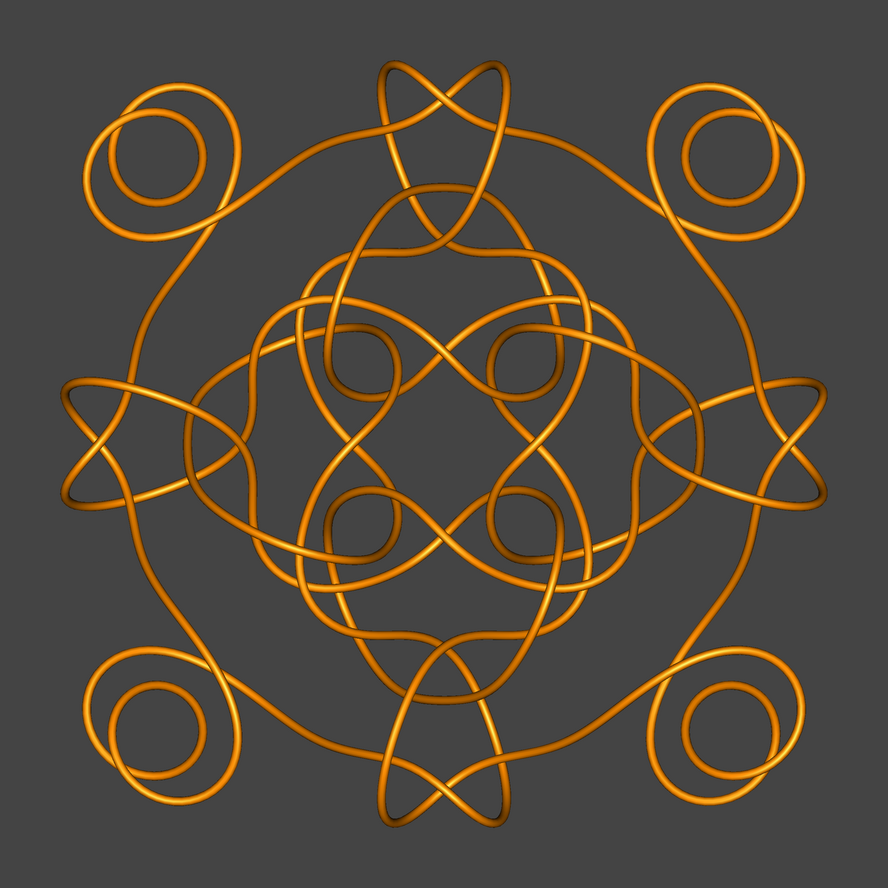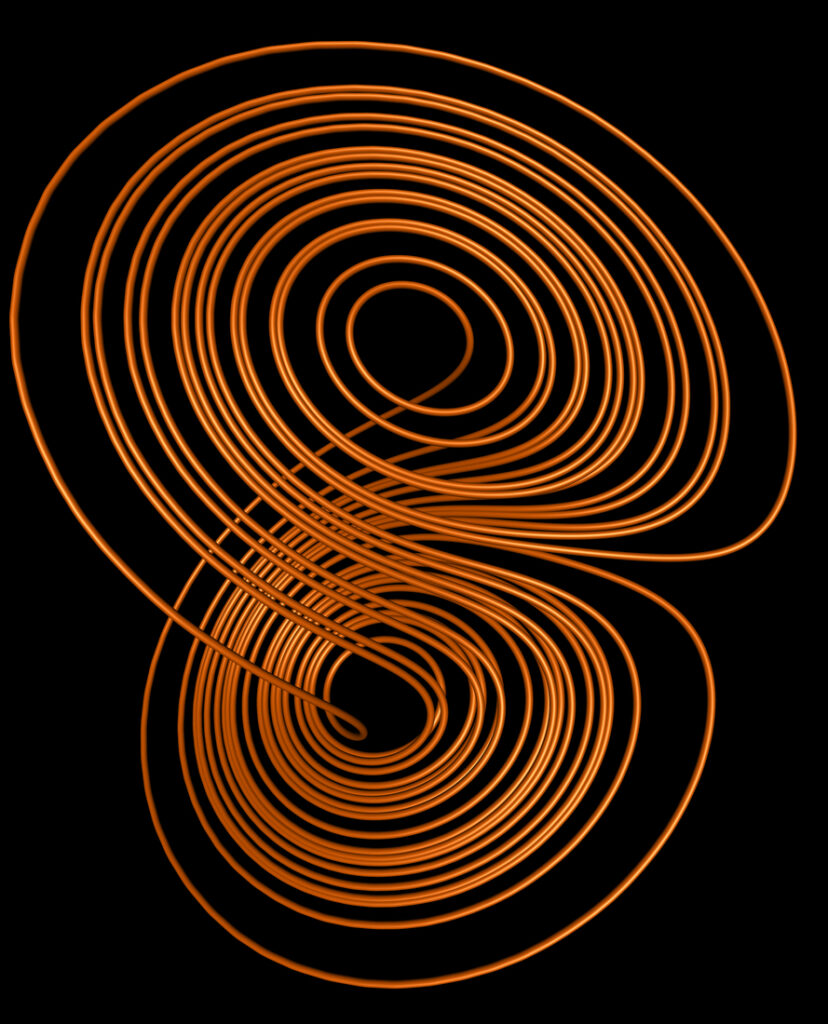Chapter 16: Knots and Motion

We can think about at least two ways of thinking about knots and motion. One is motion along a knot or link. In this case the knot is an orbit or trajectory — something follows a path that is knotted or linked. The second is a knotted object that is itself moving. Of course there could also be motion along a moving knot….
The discovery of the Lorenz attractor was one of the first developments in chaos theory. Isaac Newton once gave this advice in a coded aphorism: it is good to solve differential equations. Solutions to differential equations can be trajectories –a path a particle or body takes in the plane or through space. Newton’s signal achievement was showing that the orbit of the Earth about the Sun, an ellipse, was a particular solution to a particular differential equation.
For almost 400 years people tried to figure out what the shapes of solutions to differential equations could be. For example, solutions were found in the plane that spiraled into a point. But a general theory of the possibilities in three dimensions could not be found.
In the 1960’s the meteorologist Lorenz and coworkers were trying to model convection cycles in the atmosphere with differential equations. Cycle here just means a kind of cyclical motion. For example near the coast the air over the land might rise when the land is heated by the sun and then fall when it is over the cooler ocean, creating a cycle. If two convection cycles are near each other they might interact in the sense that air might travel around one cycle a few times then around the other, then maybe back to the first, and so on.
Lorenz found equations that modelled this behavior. When the solutions are plotted, we can see why it was so hard to categorize the shapes of solutions. In particular, depending on where in the system a pocket of air starts, its trajectory might be any sort of knot. Literally any: it has been shown that all knots can be found in the trajectories of the system.

Once Newton found that ellipses were solutions for the gravitational system of two masses, like the Sun and the Earth, the hope was to find the general solutions for systems with more masses, say, like three. But, as Newton said, he worked on this for twenty years and got nothing but a headache. Given what we saw with the Lorenz equations, it perhaps should not be surprising that the set of solutions to the gravitational equations with more than two masses is too complex to be easily categorized.
The natural retreat is to try to find solutions we can understand. One method is to use symmetry. For example, take N equal masses arranged in a regular N-gon. If we spin this arrangement about its center, it seems like there ought to be a speed such that the centrifugal acceleration will balance the pull of gravity and it will spin keeping its shape forever. This is in fact the case. For three bodies the masses don’t even have to be equal: the Sun, Jupiter and the Trojan asteroids form a rotating equilateral triangle.
If we imagine the masses distributed evenly around circles of various sizes, it is plausible that the pull of gravity toward the center depends on the size of the circle. In a small circle, the masses on both sides of a given mass pull the mass strongly toward the center, because movng a fixed distance along a small circle brings you to a direction toward the center. However, a large circle is nearly flat, so the nearby masses lay nearly on a straight line, so there is little pull toward the center. It turns this pull, in the case of many equidistributed masses on a circle, is given to frst approximation by a constant multiple of the curvature of the circle.
Now it is a well known result in physics that a mass traveling along a curve feels a centrifugal acceleration proportional to the product of the square of the velocity and the curvature toward the outside of the curve. If you drive fast around a tight curve you will feel yourself pulled to the outside of the curve.
So balancing these forces toward the inside and outside of the circle is what makes for the circular solutions. But because there is curvature on both sides of this balance, the speed required only depends on the density of the masses along the circle. So different size circles would require the same speed if they had the same density of masses. But this has the perhaps surprising implication that to first approximation, almost any closed curve could be a solution of this type, because though the curvature may change along the curve, the forces still balance.
Take for example an ellipse, or trefoil knot, or linked circles, all could be an approximate solution.
These are approximate solutions — the analysis requires many masses, and in the case of complicated curves would not be likely to persist very long. Still they are kind of fun to imagine. They are closely related to some real world phenomena. For example, we have the cowboy’s lariat. With the lariat the loop of rope has an axial motion — the rope in the loop moves along the loop, while keeping the open loop shape. Here the centrifugal force is balanced by the tensile strength of the rope. The spinning of the rope makes it want to expand into a larger circle, but the rope will not stretch.
A similar phenomenon is the driven hanging chain. Here a chain loop passes over a sprocket which is driven by a motor, so the chain has axial motion a some speed. What we find is that at sufficient speed, you can deflect the chain from its hanging shape, and the deflection will persist.
The N-body solutions are somewhat like the hanging chain, where gravity is connecting the bodies to one another along the curve.
In Chapter we mentioned Thompson’s vortex theory of the atom. Unfortunately for the theory there doesn’t seem to be any aether, so there is no way to have vorticies in it. However there is certainly air and water, and vortices are very common in those media, for example in water headed down a drain or a tornado. In these two examples the vortex core is an open curve, but it is also possible to have a closed vortex loop. Smoke rings are an example. The smoke serves to color the vortex in the air so it can be seen. There are toys that will shoot vortex rings in the air without any coloration and so can seem to effect a kind of magical force at a distance — say knock over a house of cards without something apparent touching it.
Dolphins will sometimes use their blowholes to create vortex rings in water. The rings can be seen because the vortex core is air, so the vortex core looks sort of like a tubular bubble. The rings are fairly persistent, and can be deflected and pushed about, changing shape but remaining a closed loop, and the dolphins seem to have a great time playing with them.
Vortices are sometimes used to try to explain the strange behavior of superfluid helium, which will do things like crawl up the walls of a container holding it.
So, can there be knotted vortices as Thompson envisioned them, in any media? How about linked vortex rings? Knots were shown to be theoretically possible in a relatively limited model decades ago, but recently a knotted vortex was created in water by quickly drawing a knotted shape through the water.
Linked vortex rings have been created by shooting rings at one another at an angle. This is tricky, because we know that for them to become linked they must pass through each other somewhere. Instead of passing through they may join, forming one larger ring. This question of vortex interaction and possible split and reconnection has been extensively modeled.
Gel electrophoresis is a fundamental tool in microbiology. Say you have a batch of several different sorts of molecules mixed together. Gel electrophoresis will separate them, grouping like with like.
The gel is a kind of obstacle course for the molecules — it presents obstructions for the molecules to negotiate their way around. The molecules are driven through the gel by electricity — the molecules have some charge and a current passes through the gel. Different gels will have different structures — some more regular, some with more space and fewer obstructions, etc, but the principle is the same. Now the different types of molecules typically have some characteristic that will make it easier or harder to get through the gel, so they will travel through the gell a different speeds.
For example, assume the molecules are polymers, and are chains of different lengths. Then it might easier for a shorter chain to get through than a longer one, so it will travel faster. So after some amount of time the short chains will be at some distance on average and the longer ones at a lesser distance, and this can be seen as bands in the gel.
Exactly how the molecules move through the gel has not been completely described, and perhaps simply cannot be in general — there are so many different kinds of molecules and different kinds of gels.
People have added enzymes to batches of DNA which cut and splice the chains creating various products. In particular, these operations can tie various knots in DNA. And they have been able to run these products through gels, and have the gel separate the knots, so that different knot types are in different bands.
This can be done even when the closed chains are all of the same length, that is, the same amount of DNA rope is used to make a trefoil and a figure eight, so we know it is the knot-type that is making the difference. But this is not a strictly topological matter. We know from the ropelength chapter that different knots require different lengths to tie. So imagine a star knot, a trefoil and an unknot tied in the same length of DNA. Then we might expect the star knot to be most compact of the three, because more of its length is required for tying the knot. So perhaps this compactification would make it transit the gel quicker than the other two, and this has been observed. It would be nice if this was always what was observed — that for the same length loops the more complex knots were faster.